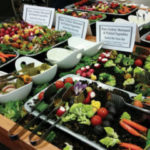Whether your attendees are from Shanghai or Madrid, Dhaka or Des Moines, they all have at least one thing in common: They need to eat. But where, how, and when you seat them, and what you feed them, can vary tremendously from country to country — meaning that North American meeting professionals who work globally must navigate a maze of local food-and-beverage practices, pricing structures, expectations, and customs.
KEEPING IT SAFE
Before anyone takes that first sip of coffee, you need to know that on-site food and drink are safe to consume. “You certainly need to have an understanding of the regulations around the food that you’re going to eat,” said Phelps Hope, CMP, senior vice president of Kellen, which oversees 400 global meetings each year, 50 of them outbound from the United States. “Let’s say there is no indication of the quality standards behind [a venue’s] food prep, storage, and so forth. Then you really want to dig deep on everything from ordering the food and how they store the food, to how they prep the food, to how they mix their raw meats with their vegetables, all those kinds of things. When you do the site inspection, go look at their walk-in cooler, and look at how the food is stored. Go on the back [loading] dock and look for rats, or spilled food, or whatever else. Go watch the prep kitchen. Have them escort you through that area.”
And don’t overlook your water supply. If municipal water is untreated, as in parts of Mexico and South America, rote acts such as brushing one’s teeth or eating a piece of rinsed fruit could have unwelcome health consequences. “Water is critical all over,” Hope said. “Ask, where is the water coming from? What are the pipe systems like? Are there nasty bacteria in the water? And if you’re going to have an open bar and you’re going to have mixed drinks and ice, where is the ice coming from? Is it purified water or not?”
ALL ABOUT TIMING
Breakfast at eight, lunch at noon, dinner at six — not everyone adheres to these traditional North American mealtimes. “Timing is something that a lot of associations that aren’t naturally global sometimes forget about,” said Michelle Crowley, PCMA’s director of global development. “When they plan a meeting in Europe, will they schedule lunch to start at noon, or more like 1 [p.m.]? If [lunch is] at one, what does that mean as far as your breaks before and after, and so forth?”
In parts of Latin America and Europe, lunch is often the longest meal of the day — and that time needs to be built into the schedule. “In Latin America, lunch is usually a sit-down, full meal with wine,” Crowley said. “If your lunch is at 1:30 p.m., it’s going to be 3:30 p.m. before you’re done.”
Also know when it’s not time to eat, such as prayer times in Middle Eastern countries. (Devout Muslims pray five times per day.) “What time are you doing your food service, and is it right on one of the prayer times?” Hope said. “If you’re going to start the buffet service right after prayer time, you’ve got a disconnect. That’s assuming you have a lot of attendees from the Middle East coming in.”
CHICKEN, FISH — OR FEIJOADA?
It can be easy to be seduced by delicious, exotic foods available in a new locale — but keep in mind not all attendees might be as enthused. “You don’t want to get overly creative with your food selection just because you’re in a sexy environment,” Hope said. “Eighty percent of the time, you’ve got to do your ‘chicken, fish, or beef’ for your attendees. You can add a certain exotic element around it, but don’t substitute; otherwise there might be nothing to eat, because people aren’t familiar with those foods.”
Nor should you count on it being easy to accommodate dietary restrictions — including attendees’ food allergies and their kosher, halal, and vegetarian diets — in certain countries, according to Caroline Hill, founder of the UK’s Eventful Solutions. That’s especially true for non-chain hotels and off-site dinners, she said, “because they might not be as savvy about all of the requirements.”
BOTTOMS UP?
Alcohol isn’t always a given at meeting functions, of course. While countries such as France, Italy, and Brazil customarily serve alcohol with lunch, in the Middle East attendees might not even have wine available with dinner. In the United Arab Emirates, for example, special licenses are required to serve alcohol; while your hotel may hold a license, not all meeting venues do.
Although not having alcohol “usually saves [planners] money,” Crowley said, “understanding the [alcohol rules] right up front is important, so that you can prepare your attendees accordingly. Also, understanding who your host is for the event, and how the host feels about alcohol, is important.” Hill agrees. “[Alcohol consumption] should be driven by the organization that’s holding the meeting,” she said, “versus the culture of the country.”
READ THE FINE PRINT
Items that you might take for granted when it comes to your F&B budget aren’t always covered in certain countries. Hope notes that condiments are part of the final F&B bill in Australia. Likewise, Crowley said, “In many facilities [in Brazil], you need to pay for the sugar and milk that you typically have for coffee.”
Hill carefully examines contracts to recalculate quantities and expectations as necessary, especially when it comes to beverages during lunch. “When venues are quoting the delegate rate, room hire, teas and coffees, and the like, you have to be careful whether equipment is included, how many teas or coffees, whether drinks are included with lunch,” she said. “Or they give you two coffee breaks, and you need three. If it isn’t included when you go to another country and it’s not in your experience, that’s where you can fall down — you forget to ask the question, and then you forget to add it to your budget.”
Hill’s parting advice: Find a local partner — and let them guide you. “Make sure you use a really reputable, well-known DMC as a partner,” she said, “and they will have that key knowledge of an area.”





